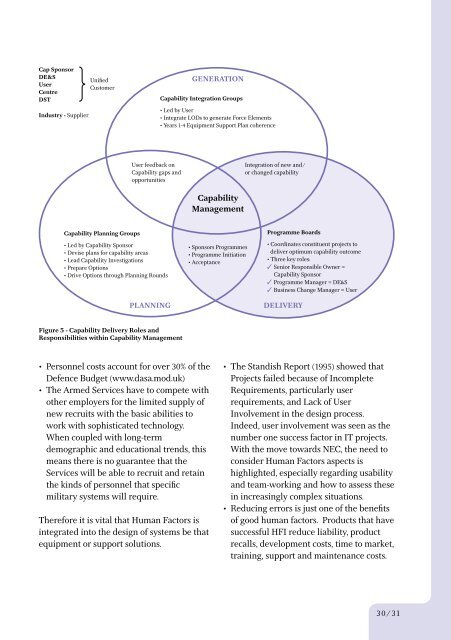The people in sysTems Tlcm handbook - Human Factors Integration ...
The people in sysTems Tlcm handbook - Human Factors Integration ...
The people in sysTems Tlcm handbook - Human Factors Integration ...
You also want an ePaper? Increase the reach of your titles
YUMPU automatically turns print PDFs into web optimized ePapers that Google loves.
Cap Sponsor<br />
DE&S<br />
User<br />
Centre<br />
DST<br />
Industry - Supplier<br />
Unified<br />
Customer<br />
Generation<br />
Capability <strong>Integration</strong> Groups<br />
• Led by User<br />
• Integrate LODs to generate Force Elements<br />
• Years 1-4 Equipment Support Plan coherence<br />
User feedback on<br />
Capability gaps and<br />
opportunities<br />
<strong>Integration</strong> of new and/<br />
or changed capability<br />
Capability<br />
Management<br />
Capability Plann<strong>in</strong>g Groups<br />
• Led by Capability Sponsor<br />
• Devise plans for capability areas<br />
• Lead Capability Investigations<br />
• Prepare Options<br />
• Drive Options through Plann<strong>in</strong>g Rounds<br />
Plann<strong>in</strong>g<br />
• Sponsors Programmes<br />
• Programme Initiation<br />
• Acceptance<br />
Programme Boards<br />
• Coord<strong>in</strong>ates constituent projects to<br />
deliver optimum capability outcome<br />
• Three key roles:<br />
3 Senior Responsible Owner =<br />
Capability Sponsor<br />
3 Programme Manager = DE&S<br />
3 Bus<strong>in</strong>ess Change Manager = User<br />
delivery<br />
Figure 5 - Capability Delivery Roles and<br />
Responsibilities with<strong>in</strong> Capability Management<br />
• Personnel costs account for over 30% of the<br />
Defence Budget (www.dasa.mod.uk)<br />
• <strong>The</strong> Armed Services have to compete with<br />
other employers for the limited supply of<br />
new recruits with the basic abilities to<br />
work with sophisticated technology.<br />
When coupled with long-term<br />
demographic and educational trends, this<br />
means there is no guarantee that the<br />
Services will be able to recruit and reta<strong>in</strong><br />
the k<strong>in</strong>ds of personnel that specific<br />
military systems will require.<br />
<strong>The</strong>refore it is vital that <strong>Human</strong> <strong>Factors</strong> is<br />
<strong>in</strong>tegrated <strong>in</strong>to the design of systems be that<br />
equipment or support solutions.<br />
• <strong>The</strong> Standish Report (1995) showed that<br />
Projects failed because of Incomplete<br />
Requirements, particularly user<br />
requirements, and Lack of User<br />
Involvement <strong>in</strong> the design process.<br />
Indeed, user <strong>in</strong>volvement was seen as the<br />
number one success factor <strong>in</strong> IT projects.<br />
With the move towards NEC, the need to<br />
consider <strong>Human</strong> <strong>Factors</strong> aspects is<br />
highlighted, especially regard<strong>in</strong>g usability<br />
and team-work<strong>in</strong>g and how to assess these<br />
<strong>in</strong> <strong>in</strong>creas<strong>in</strong>gly complex situations.<br />
• Reduc<strong>in</strong>g errors is just one of the benefits<br />
of good human factors. Products that have<br />
successful HFI reduce liability, product<br />
recalls, development costs, time to market,<br />
tra<strong>in</strong><strong>in</strong>g, support and ma<strong>in</strong>tenance costs.<br />
30/31

















